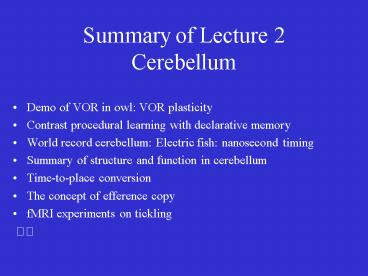Summary of Lecture 2 Cerebellum - PowerPoint PPT Presentation
1 / 17
Title:
Summary of Lecture 2 Cerebellum
Description:
fMRI experiments on tickling. Procedural Memory. Gain of reflexes (e.g. VOR) ... Why it is hard to tickle yourself. Cerebellum activated by externally produced ... – PowerPoint PPT presentation
Number of Views:185
Avg rating:3.0/5.0
Title: Summary of Lecture 2 Cerebellum
1
Summary of Lecture 2Cerebellum
- Demo of VOR in owl VOR plasticity
- Contrast procedural learning with declarative
memory - World record cerebellum Electric fish
nanosecond timing - Summary of structure and function in cerebellum
- Time-to-place conversion
- The concept of efference copy
- fMRI experiments on tickling
2
(No Transcript)
3
Procedural Memory
- Gain of reflexes (e.g. VOR)
- Conditioned reflexes (e.g. eye blink)
- Skilled sequences (e.g. cycling, typing)
4
Vestibulo-Ocular Reflex (VOR)
- Fastest reflex in brain
- Operates perfectly without cerebellum
- (i.e. same conditions)
- But gain adaptation requires cerebellum
- (i.e. as conditions change, such as growth,
ageing, muscle strength, oxidative damage etc)
5
- VOR circuit
- 1. Vestibular hair cell
2. Vestibular neuron
3. Oculomotor neuron
Only 2 synapses. Purkinje cell modulates
VOR reflex at vestibular neuron
6
Trout Electric Fish
7
Basic fish
Electric Fish
8
(No Transcript)
9
Forebrain
Cerebellum
10
- Purkinje Cell.
- Only output of cerebellum
- GABAergic inhibition
- 106 spine synapses
- Spines modifiable by LTD
- Climbing fibrePunishes
- co-active spine synapses
11
- Excitatory Inputs.
- Mossy fibre to
- granule cells to
- parallel fibres to
- spine synapses
- on Purkinje cells
- Vast combinations
- provide the sensory
- context
12
- Interneurons.
- Golgi for Granule cells
- Basket and Stellate for Purkinje cells
- Inhibitory
- (GABA, glycine etc)
- Diversity increases
- With cerebellar complexity
- (greatest variety in
- anthropoid primates)
13
- Time-to-Place Conversion
- Purkinje cells along beam
- of parallel fibres
- e.g. 10 m/sec gives 10 mm/msec
- or 10 mm/msec.
- So a 10 mm spacing
- between Purkinje cells
- allows a time resolution
- of 10 msec.
- Electric fish achieve
- nanosecond timing with
- larger, faster beams.
4
3
2
1
14
- Time-to-Place Conversion
- Purkinje cells along beam
- of parallel fibres
- e.g. 10 m/sec gives 10 mm/msec
- or 10 mm/msec.
- So a 10 mm spacing
- between Purkinje cells
- allows a time resolution
- of 10 msec (humans).
- Electric fish achieve nanosecond
- timing with larger, faster beams.
msec
30
20
10
0
15
Efference Copy
- Spatio-temporal pattern of activity that is
copied from the motor output to the sensory
system so that the sensory consequences of the
motor act can be precisely annulled. - Hallucinations are d/t aberrant efference copy
- Cerebellum produces efference copy
- Why it is hard to tickle yourself
16
Cerebellum activated by externally produced
tactile stimuli
Anterior lobe Talairach coordinates 16 -44 -32 Z
4.24 PSelf-produced tactile stimuli
Rest
Externally- produced tactile stimuli
Self-produced movement
17
Declarative vs Procedural Memory
- Forebrain
- Single trial possible
- Creative fraction of inputs
- LTP
- Error-prone
- ?Sleep needed
- Hindbrain
- Many trials needed
- Stupid needs all inputs
- LTD
- Precise
- Corrected in waking state































